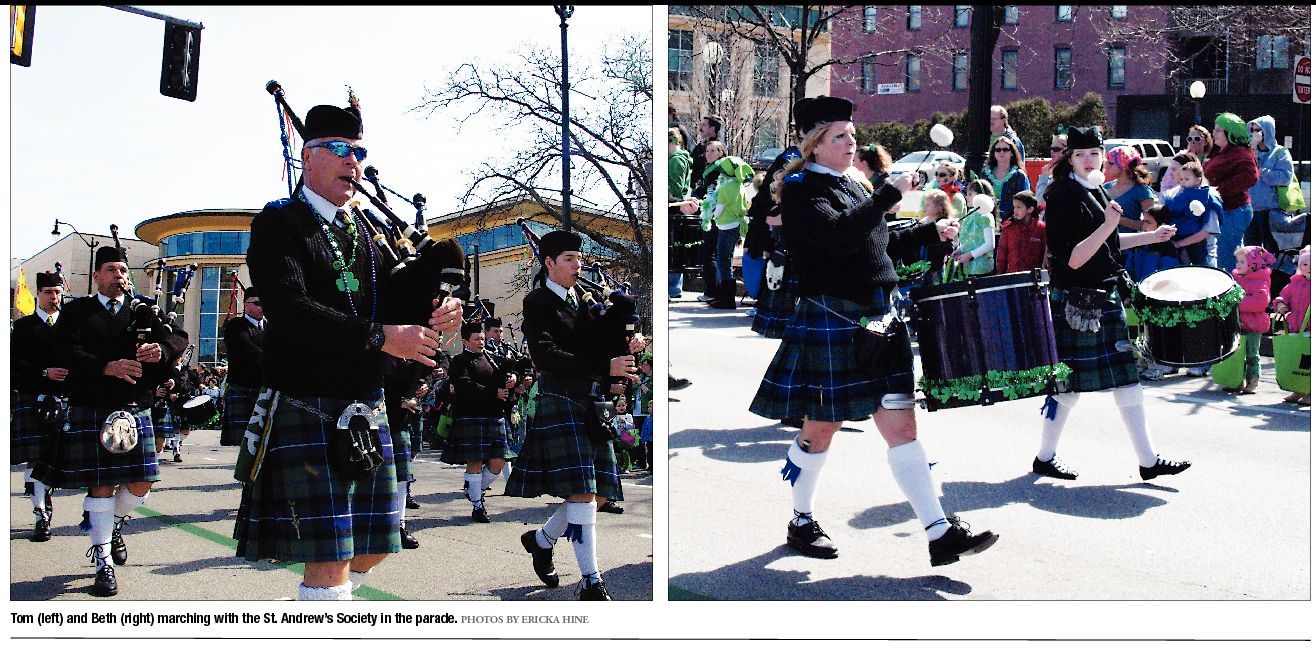
The pipes are calling
continued from page 13
“Lot of people might have some Celtic in them and they don’t even know it,” Tom says. “They hear the bagpipes and it stirs something in them that draws them to find out about their heritage.”
As educators and performers, Tom and Beth bring a particular charm and noticeable experience to the teaching realm, not the least of which is a huge respect for what the arts can do for students, and for people in general, beyond the simple act of artistry, delving into the psyche and persona for improvement on many levels.
“If someone is in music, I think their grades do better in school, it gives them more confidence,” says Tom. “From the outside it seems we’re a strange lot or we’re just a small group of people, but we’ve made friends throughout North America, in Scotland and other places. And the students get that too. When you’re in it, it’s amazing how many peo ple are really into this. This pied piping has taken me all over the world.”
When Tom was “12 or 13” he and other young pipers and dancers left Michigan on a “world tour by bus” of the Expo ’67 in Montreal, West Point, Red Bank, N.J., Washington, D.C., and then finished with a show at Gettysburg. He moved to Chicago in 1982 from Michigan to play in one of the best bagpipe bands in the Midwest and still continues his musical journey that included shows with celebrity performers such as Rod Stewart, the Chieftains and others. During the recent earthquake in Christchurch, Australia, Beth checked on Facebook to inquire about Tom’s piping friends there and found out they were fine.
Considered one of the finest pipers anywhere, he now leads a local group, belongs to a world class competing band in Chicago and teaches all comers, including students from as far away as St. Louis, Galesburg and Bloomington, or as close as right down the road. Under his leadership, the St. Andrew’s Society of Central Illinois Pipes and Drums won awards at several competitions all over North America. He’s known for being a demanding teacher, but both he and Beth work their students hard to achieve results, expecting only what they expect from themselves.
“I believe if you’re not learning you’re standing still, so I have to teach my students as if they’re competing,” says Tom. “We do several competitions but it’s only 20 percent of what our band does – 80 percent is parades and performances.”
“That’s one of the things both of us do and is part of our basic philosophy as teachers. Whether a student wants to compete or do it for fun, we teach you as if you are going to compete, because that is the judging standard of excellence,” explains Beth.
“Sometimes we might lose people over that principle, but it’s our way.”
One of the most obvious byproducts of the Ogilvys’ passion for teaching and performing is the camaraderie among the pipers, drummers and dancers and their families involved within the circle of Celtic culture. From all walks of life and whether they come, go or stay until the last drink, dance, song and step is done, there’s a noticeable bond of familial friendship formed that goes beyond lessons and learning.
“We don’t do any advertising so they search us out. I don’t consider my dancers as clients or just students, they’re family,” says Beth. “It’s not uncommon for us to have several kids and families staying with us before driving to St. Louis or Florida or wherever for competitions. We’ve got three couches, four bedrooms, blowup mattresses – there’ll be bodies everywhere. We live together and travel together like being in the circus.”
The most hectic time is right now during the St. Patrick’s Day celebrations that nearly cover the entire month of March. The pipe and drum band and the dancers are in demand all over central Illinois as everyone of whatever ethnicity shares in the Irish heritage commemoration. From bars and clubs to parades, schools, nursing homes and wherever the call comes, the kilts get swinging, the pipes stay blaring, the drums keep beating and the dancers go stepping out, allowing the world to experience the ancient Celtic ways for a few fleeting moments.
“We have nine nursing homes and senior centers on St. Patrick’s Day. We go to them because they can’t get out,” says Beth. “Tommy pipes, my father tells stories and the dancers dance. We also go to
small towns all over for parades. Tommy calls it St. Patrick’s Day week.
This year we started on March 4 and end on March 19.”
They
sacrifice time for producing art and preserving culture, missing
holidays and weddings, family birthdays and graduations, attempting to
make them up later when the performance schedule permits. It’s not easy,
and it’s certainly not for everyone, but the Ogilvys see it not from
the perspective of working, but as a life’s work that continues on a
link from time immemorial to forthcoming generations, preserving a past
for the present while creating the possibility of a future with
tradition. And one more thing: they really enjoy what they do.
“What
else could we do where we could meet the people we meet and have the
experiences we have and have so much fun?” says Beth. “We are quite
unique in that the St. Andrew’s Society of Central Illinois is one of
the only societies that get together for a Robert Burns dinner, host
Highland games, have a pipe and drum band plus Irish and Scottish
dancers, and an Ancient Athletics organization all in the same place.”
“We
don’t do it because we’re trying to do it all for the power or the
glory, but we love what we’re doing,” says Tom. “We’re still here and
we’ll stay because we believe in what we’re doing.”
Contact Tom Irwin at [email protected].
